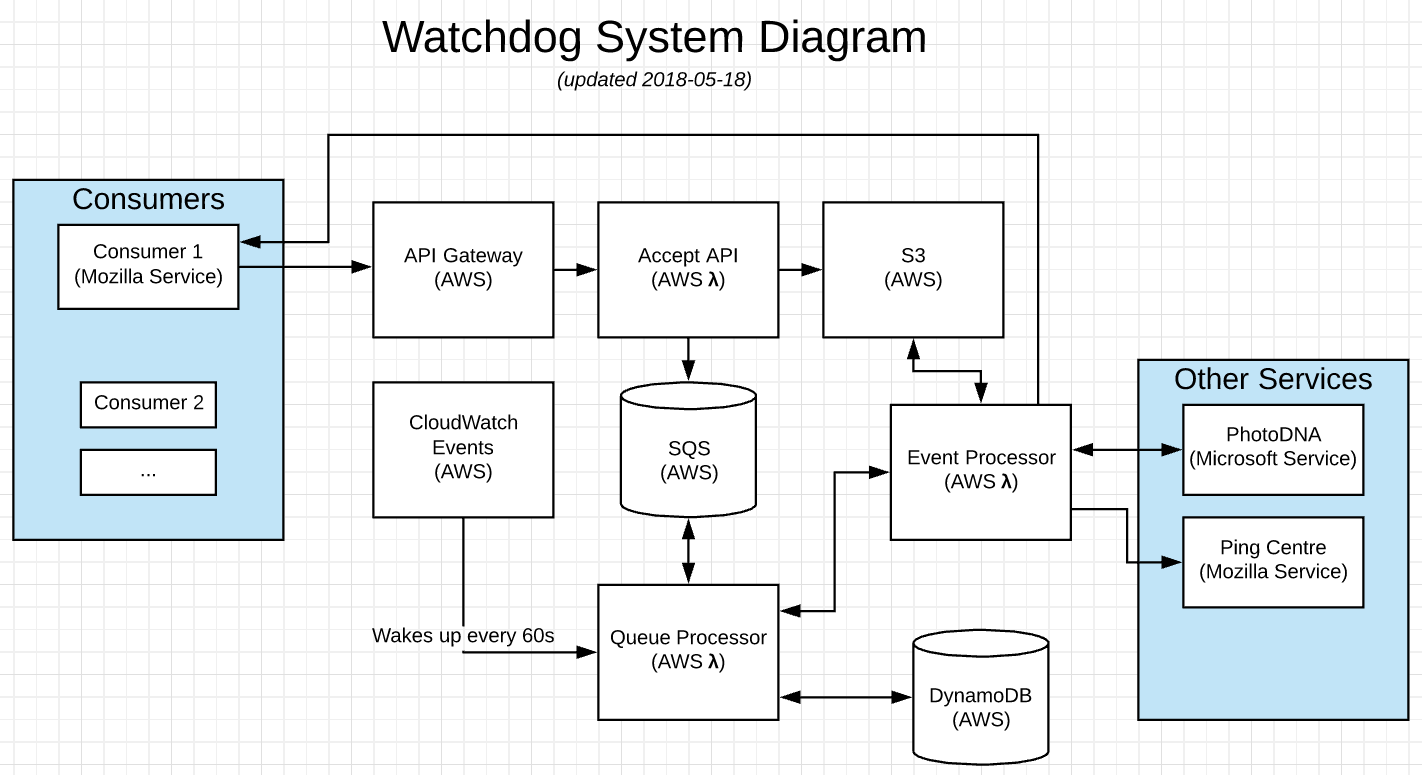- Docs and config files for setting up custom domain name - Add deploy_dev job to successful build & test runs on master branch in CI - Temporarily switch to a specific commit of serverless to address upstream issue: https://github.com/serverless/serverless/issues/4957 - Temporarily switch to a specific branch of serverless-domain-manager to address upstream issue: https://github.com/amplify-education/serverless-domain-manager/issues/64#issuecomment-370102422 Issue #11 |
||
|---|---|---|
| .circleci | ||
| bin | ||
| docs | ||
| functions | ||
| lib | ||
| .editorconfig | ||
| .eslintrc.yaml | ||
| .gitignore | ||
| LICENSE | ||
| README.md | ||
| package-lock.json | ||
| package.json | ||
| renovate.json | ||
| serverless.dynamicConfig.js | ||
| serverless.local.yml-dist | ||
| serverless.yml | ||
README.md
watchdog-proxy
This is a simple proxy which interfaces with Microsoft's PhotoDNA Service.
Systems Diagram

Development
Useful NPM scripts
npm run lint- check JS syntax & formattingnpm run test- run JS testsnpm run watch- start a file watcher that runs tests & lintnpm run prettier- clean up JS formattingnpm run deploy- deploy a stack configured for productionnpm run deploy:dev- deploy a stack configured for development (e.g. withENABLE_DEV_AUTH=1)npm run info- display information about the currently deployed stack (e.g. handy for checking the stack's API URL)npm run logs -- -f accept -t- watch logs for the functionacceptnpm run client -- [--id <id> --key <key>] <url>- make an authenticated request to<url>using Hawk credentials, defaults to dev credentials devuser / devkey enabled withENABLE_DEV_AUTHenv var on deploy
Quickstart Notes
First, ensure node.js 8.11.1 or newer is installed. Then, the steps to get started look something like this:
git clone git@github.com:mozilla/watchdog-proxy.git
cd watchdog-proxy
npm install
npm start
After cloning the repository and installing dependencies, npm start will launch several file watchers that build assets as needed, run unit tests, and check code quality as you edit files.
Now, create your own version of serverless.local.yml:
- Copy
serverless.local.yml-disttoserverless.local.yml - Edit
serverless.local.yml - Change at least the
stageproperty to a name that's unique to you - (optional) Change
upstreamService.urlto the URL of a debugging service like webhook.site
The next step is to get the service running on AWS. You'll need to sign up for an account or request a Dev IAM account from Mozilla Cloud Operations. (The latter is available only to Mozillians.)
Optional: Install AWS CLI. This gives you tools to work with AWS from the command line.
If you already have an AWS key ID and secret, you can follow the quick start docs for Serverless to configure your credentials
If you don't already have an AWS key ID and secret, follow the guide to acquire and configure these credentials.
Try deploying the service to AWS:
npm run deploy:dev
You should see output like the following:
$ npm run deploy:dev
Serverless: Packaging service...
Serverless: Excluding development dependencies...
Serverless: Creating Stack...
Serverless: Checking Stack create progress...
.....
Serverless: Stack create finished...
Serverless: Uploading CloudFormation file to S3...
Serverless: Uploading artifacts...
Serverless: Uploading service .zip file to S3 (6.39 MB)...
Serverless: Validating template...
Serverless: Updating Stack...
Serverless: Checking Stack update progress...
...........................................................................
Serverless: Stack update finished...
Service Information
service: watchdog-proxy
stage: lmorchard
region: us-east-1
stack: watchdog-proxy-lmorchard
api keys:
None
endpoints:
GET - https://30r00qsyhf.execute-api.us-east-1.amazonaws.com/lmorchard/accept
functions:
accept: watchdog-proxy-lmorchard-accept
pollQueue: watchdog-proxy-lmorchard-pollQueue
processQueueItem: watchdog-proxy-lmorchard-processQueueItem
If everything was successful, you should now have a running stack with an HTTPS resource to accept requests listed as one of the endpoints. Copy the listed endpoint URL and keep it handy.
To send your first request, use the client script with the GET endpoint URL:
npm run client
With no options, this command should attempt to auto-detect the endpoint URL for your deployed stack. You can check to see the results of this request working its way through the stack with the following log commands:
# Client request is accepted into the queue
npm run logs -- -f accept
# Client request is received from the queue
npm run logs -- -f pollQueue
# Queued job is processed
npm run logs -- -f processQueueItem
# Upstream service receives a request
npm run logs -- -f mockUpstream
# Client callback service receives a negative result
npm run logs -- -f mockClientNegative
# Client callback service receives a positive result
npm run logs -- -f mockClientPositive
If you want to remove this stack from AWS and delete everything, run npm run remove
The Serverless docs on workflow are useful.
Custom stable domain name for local development
By default, no custom domain name is created. You can use the semi-random domain name serverless offers on deployment and with serverless info.
If you want to create a domain name for local development (e.g. watchdog-proxy-lmorchard.dev.mozaws.net):
- Edit your
serverless.local.ymlto contain an enabledcustomDomainsection with appropriate details - Run
npx serverless create_domain- this only needs to be done once, to create the new custom domain name in Route53 and an accompanying CloudFront distribution - Run
npm run deploy:devto update your stack
Read this Serverless Blog post for more details: https://serverless.com/blog/serverless-api-gateway-domain/
Deployment
Environment variables
When using serverless deploy to deploy the stack, you can use several environment variables to alter configuration:
STAGE- Stage for building and deploying - e.g.dev,stage,productionDOMAIN- Custom domain config selection for Route 53 and CloudFront distribution - e.g.local,dev,stage,production. If omitted, custom domain handling is disabledNODE_ENV- Useproductionfor a more optimized production build,developmentfor a development build with more verbose logging and other conveniencesGIT_COMMIT- The value reported by the__version__resource ascommit. If not set, Serverless config will attempt to run thegitcommand to discover the current commit.UPSTREAM_SERVICE_URL- the URL of the production upstream web service (i.e. PhotoDNA)UPSTREAM_SERVICE_KEY- the private subscription key for the upstream web serviceENABLE_DEV_AUTH=1- This enables a hardcoded user id / key for development (off by default)DISABLE_AUTH_CACHE=1- Authentication credentials are cached in memory in theacceptAPI function. This lasts until AWS recycles the container hosting the function. Setting this variable disables the cache.
You can see these variables used by scripts defined in package.json for development convenience.